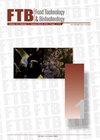添加了不同粒径西瓜皮粉的高纤维通心粉的质量
IF 2.5
4区 农林科学
Q3 BIOTECHNOLOGY & APPLIED MICROBIOLOGY
引用次数: 0
摘要
研究背景。西瓜皮是西瓜汁加工的副产品,含有大量膳食纤维和具有抗氧化能力的酚类物质。利用农工副产品可以提高经济效益,减少环境排放。本研究的目的是考察西瓜皮粉的粒度对高纤维面食质量的影响。实验方法:三种西瓜皮粉样品分别通过孔径为 400、210 和 149 μm 的三个筛子,测定其营养、物理和理化质量。然后将小麦硬质小麦粉和西瓜皮粉(质量比为 90:10)混合并用于制作意大利面。对添加了不同粒度的西瓜皮粉的高纤维面食的营养、质地和烹饪质量、感官可接受性、体外血糖生成指数和抗氧化剂生物利用率进行了评估和比较。当筛孔尺寸从 400 微米减小到 149 微米时,西瓜皮粉的可溶性膳食纤维和总酚含量分别提高了 35%和 15%,而不溶性膳食纤维含量则降低了 21%。将西瓜皮粉的筛孔尺寸从 410 微米减小到 149 微米后,强化面食的酚类生物可及性从 63% 降至 57%,但其预测血糖生成指数从 50 升至 69;筛孔尺寸的减小还使面食硬度降低了 13%,但其伸长率和拉伸强度分别提高了 13% 和 40%。西瓜皮粉颗粒越细,最佳烹饪时间越长,吸水指数越高,添加西瓜皮粉的面食的烹饪损失越小。消费者对所有面食样品的总体接受度均无明显差异。西瓜皮粉的粒度对强化面食的营养、质地和烹饪质量有很大影响。特别是,配方中使用的膳食纤维材料的粒度对高纤维意大利面的预测血糖生成指数和抗氧化剂生物利用率有显著影响。本文章由计算机程序翻译,如有差异,请以英文原文为准。
Quality of High-Fiber Pasta Supplemented with Watermelon Rind Powder with Different Particle Sizes
Research background. Watermelon rind, a by-product of watermelon juice processing, contains high amounts of dietary fiber and phenolics with antioxidant capacity. The use of agro-industrial by-products would improve the economic benefits as well as reduce the environmental emissions. The goal of this research was to examine the impacts of particle size of watermelon rind powder on the quality of high-fiber pasta.
Experiment approach. Three samples of watermelon rind powder passed through three sieves with aperture sizes of 400, 210, and 149 μm were determined for their nutritional, physical and physicochemical quality. Wheat durum semolina and watermelon rind powder (90:10 by mass) were then mixed and used to make pasta. Nutritional, textural, and cooking quality, sensory acceptability, in vitro glycemic index, and antioxidant bioaccessibility of high-fiber pasta added with watermelon rind powder with different particle size means were evaluated and compared.
Results and conclusions. When the sieve aperture size was reduced from 400 to 149 µm, the soluble dietary fiber and total phenolic contents of watermelon rind powder were enhanced by 35 and 15%, respectively while its insoluble dietary fiber content was decreased by 21%. Decrease in sieve aperture size from 410 to 149 µm for watermelon rind powder reduced phenolic bioaccessibility of the fortified pasta from 63 to 57% but enhanced its predicted glycemic index from 50 to 69; such decrease also lowered the pasta hardness by 13% but improved its elongation rate and tensile strength by 13 and 40%, respectively. The finer the watermelon rind powder particles, the longer the optimal cooking time, the greater the water absorption index, and the less the cooking loss of the supplemented pasta. Consumers did not notice any significant difference in the overall acceptability among all pasta samples.
Novelty and scientific contribution. Particle size of watermelon rind powder had great impacts on nutritional, textural and cooking quality of the fortified pasta. Particularly, the predicted glycemic index and antioxidant bioaccessibility of high-fiber pasta were significantly affected by the particle size of dietary fiber material used in the recipe.
求助全文
通过发布文献求助,成功后即可免费获取论文全文。
去求助
来源期刊

Food Technology and Biotechnology
工程技术-生物工程与应用微生物
CiteScore
3.70
自引率
0.00%
发文量
33
审稿时长
12 months
期刊介绍:
Food Technology and Biotechnology (FTB) is a diamond open access, peer-reviewed international quarterly scientific journal that publishes papers covering a wide range of topics, including molecular biology, genetic engineering, biochemistry, microbiology, biochemical engineering and biotechnological processing, food science, analysis of food ingredients and final products, food processing and technology, oenology and waste treatment.
The Journal is published by the University of Zagreb, Faculty of Food Technology and Biotechnology, Croatia. It is an official journal of Croatian Society of Biotechnology and Slovenian Microbiological Society, financed by the Croatian Ministry of Science and Education, and supported by the Croatian Academy of Sciences and Arts.
 求助内容:
求助内容: 应助结果提醒方式:
应助结果提醒方式:


